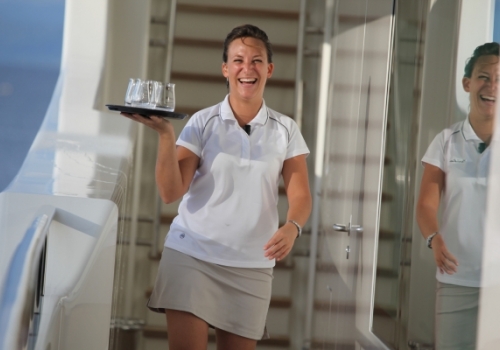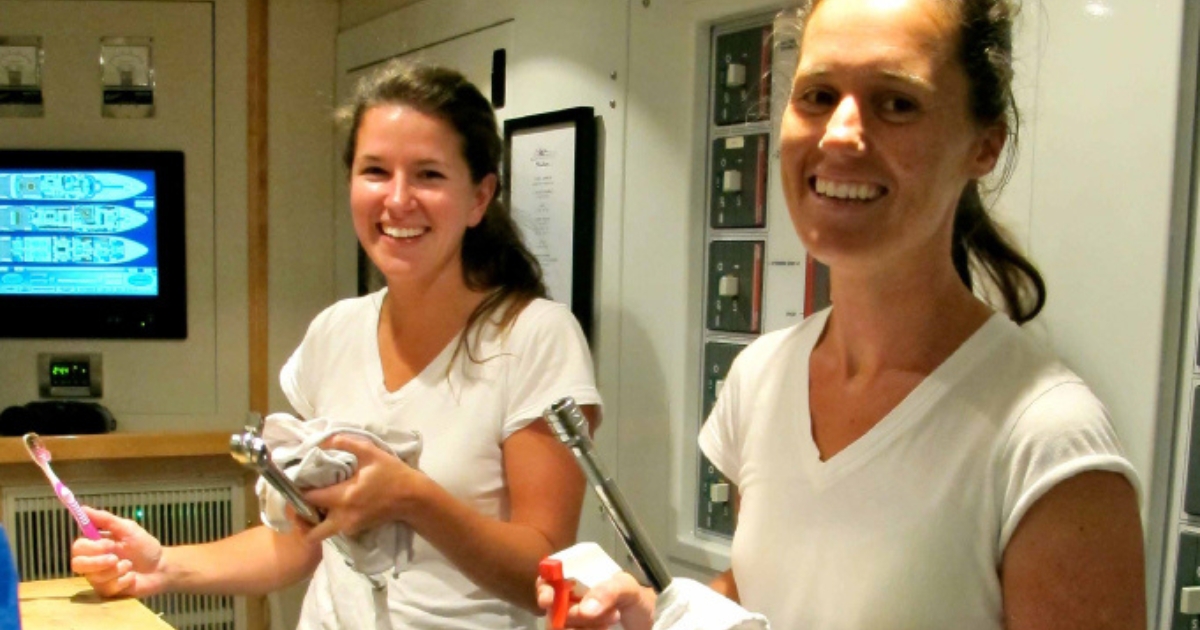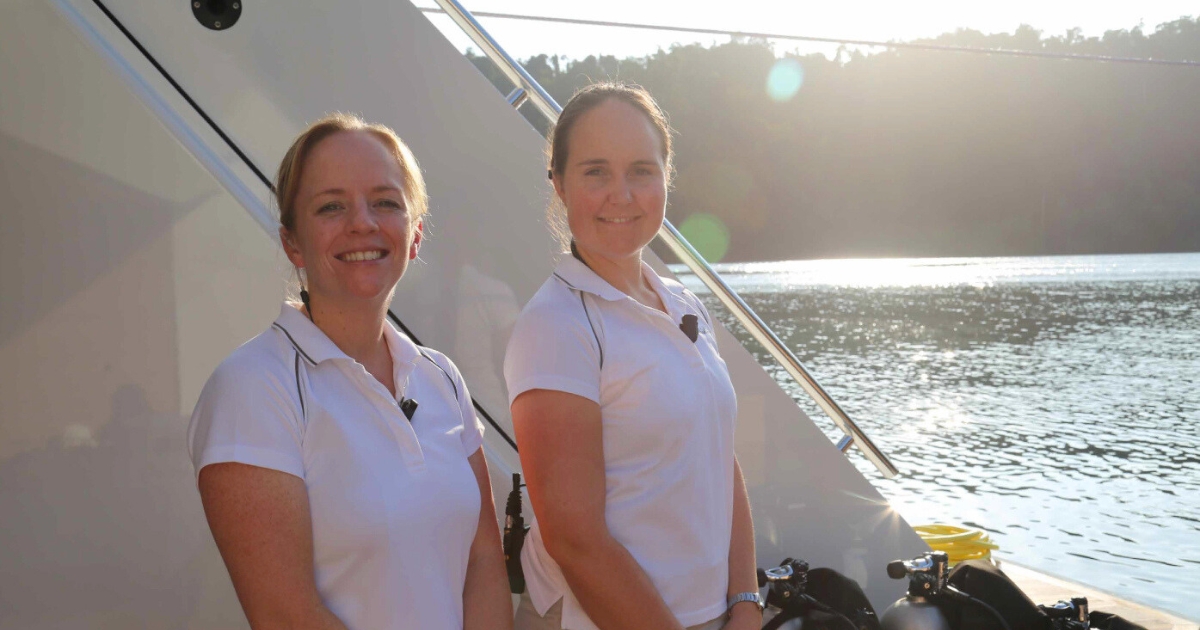The Quick and Easy Guide to Superyacht Interior Careers

Following the success of our ‘Quick and Easy Guide to Superyacht Deck Careers’, we step inside and offer our take on how to enter and get ahead in the interior department.
To ensure that we are up to speed with all of the latest requirements, we take our lead from the recently-launched careers guidance platform, Academy by Ephemeris, whose comprehensive interior pathway clearly lays out all of the steps you need to follow in order to succeed in your yachting career.
Stewardess: The day-to-day
At the entry-level position of the interior pathway, stewardesses are responsible for maintaining the interior on board a yacht and providing five-star service to owners and guests at all times. The role encompasses varied tasks such as laundry, housekeeping, interior detailing, flower arranging, food and beverage service and onboard event planning.
Reporting to the second stewardess, chief stewardess or even the captain, depending on the size of the yacht, the steward/ess role requires a strong work ethic, a great deal of organisation, attention to detail and discretion, as well as a willingness to listen and learn the ropes on the job.
A junior stewardess within the interior team on a 45-50m+ boat would typically start their career in housekeeping and laundry rather than in service. In contrast, on a smaller yacht, the stewardess can be a department of just one person, with responsibility for all the interior duties on board. This could include setting up and preparing meals, housekeeping, laundry, organising guest activities, formal meal service, cabin turndowns, and the list goes on!
As the interior team enjoys the most face-to-face time with guests and is responsible for communicating their wishes to the captain, chef and deck department, it is important to maintain good communication, high levels of professionalism, and a positive attitude at all times when undertaking this role.
How do I become a stewardess? Qualifications and training
Since it is the entry-level position for the interior pathway, one of the advantages of the junior steward/ess role is that it does not require many qualifications or schooling, meaning that it serves as the perfect gateway to start your career onboard.

As outlined on Academy by Ephemeris’ interior pathway, all crew need to show evidence of having completed STCW basic safety training (a five-day course), as well as an ENG1 medical certificate. In addition, some yachts may also require certification in Food Safety and Hygiene (a one-day course which can be completed in person or online). Yachts to which the ISPS Code applies require all crew to be trained and hold a Proficiency in Security Awareness (PSA) certificate (this is a half-day course that can be completed online).
If you are looking to upskill and ensure your CV stands out from the crowd, there are many options for more specific interior training across areas such as administration, galley, laundry, interior management, silver service, drink mixology, flower arranging, and much more. See the Academy by Ephemeris website for a list of accredited courses.
Chief Stewardess: The day-to-day
Providing that a yacht's interior department consists of more than one individual, the chief stew is responsible for managing the schedule and maintenance of the interior, as well as ensuring that guests receive excellent service.
The chief stew oversees and trains the team in all aspects of the interior department to ensure everything is executed to the highest standard, encompassing tasks such as general cleaning and bed making, folding laundry, polishing silver and creating flower arrangements, and delivering professional and impeccable levels of service.
How do I become a chief stewardess? Qualifications and training
Once you have shown evidence of the basic safety qualifications outlined above, unlike with many senior deck positions, there is no a set list of mandatory qualifications which are required to be eligible to apply for chief stewardess roles.
Instead, for those looking to climb the interior career ladder, hirers/recruiters look for candidates with appropriate experience, competence, organisational skills and evidence of effective team management. That said, any additional courses undertaken serve as evidence to employers that you are career minded and willing to invest in your own development.

There is a plethora of options for you to explore which are outlined on the Academy by Ephemeris interior pathway, including Advanced Laundry Service, Advanced Food and Beverage Service, Cigar Service, Floristry and Plant Maintenance, and many more.
Purser: The day-to-day
If you enjoy figures, have a calm head on your shoulders and are supremely organised, the job of a yacht purser may be the one for you and serve as an alternative option to becoming a chief steward/ess.
Still under the remit of the interior department, the yacht purser is a senior role who reports to the captain, often taking on some of the duties and administration, which would be completed by the captain or chief stewardess on smaller yachts. Although the role varies depending on the needs of each individual yacht, the purser can serve as the head of the interior and manage the interior team.
Day to day, the purser is responsible for ensuring the smooth and effective operations of the yacht, encompassing finances, crew management and administration, guest and crew travel arrangements, administrative tasks and much more. The purser oversees accounting, purchasing, inventories and may also assist the captain with compliance and certification requirements, and the planning of guest itineraries.
How do I become a purser? Qualifications and training
Although there are no mandatory training requirements for pursers, it would be wise for prospective candidates to consider that this is a senior role requiring knowledge and skills across many different areas and departments. This includes administration, finance, maritime law, safety and security awareness, an understanding of ISPS and ISM protocols, as well as strong computer skills.
Those with an existing degree in business, finance or accounting may already be well suited to the role. However, if you do not immediately recognise yourself in this description, there’s no need to panic!

There are numerous purser courses you can undertake to bring yourself up to speed. These cover topics including VAT, crew administration and vessel operations, human resource management, customs and immigration, and much more. Details of these courses can be found on the Academy by Ephemeris interior pathway.
Sarah Stanger, a spokesperson from Academy by Ephemeris says: “If you are looking to climb the interior career ladder, it is vital to always maintain focus on your professional and personal development, which can be tricky in the demanding working environment faced by crew. Our interior pathway helps to lay out the steps which you need to follow in an intuitive and straightforward way, which is totally unique amongst superyacht career guidance platforms.”
To explore interior pathways for yourself, visit the Academy by Ephemeris website here.


Post your comment
You cannot post comments until you have logged in.
Login to post a commentComments
No one has commented on this page yet.
RSS feed for comments on this page | RSS feed for all comments